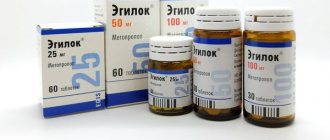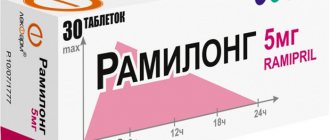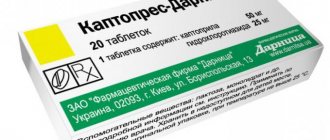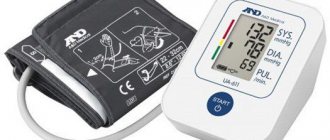Composition and release form
The drug is available in the form of a concentrate intended for the preparation of solutions for infusion, or in the form of white tablets. The solution may be slightly greenish or colorless and transparent. Cavinton is produced in 2-ml dark glass ampoules, packaged in rubber cassettes and cardboard boxes.
The drug in tablet form is available in doses of 5 milligrams.
1 milliliter of the drug contains:
- Vinpocetine (5 milligrams) - active ingredient;
- ascorbic acid - 0.5 milligrams;
- sodium bisulfite - 1 milligram;
- tartaric acid - 10 milligrams;
- sorbitol - 80 milligrams;
- benzyl alcohol - 10 milligrams;
- water - no more than 1 milliliter.
Cavinton tablets contain:
- silica;
- talc;
- lactose monohydrate;
- magnesium stearate;
- corn starch.
Instructions for use
Cavinton in tablet form is used after meals, 1 piece 3 times a day. The maximum daily dose should not exceed 6 tablets of 5 milligrams. The duration of the therapeutic course can be from 1 to 8 months.
Improvement in the patient's condition can be seen 7-8 days after the start of therapy. Due to the fact that taking tablets is addictive, the dose should be gradually reduced until the end of the course. Over 3 days, the dose of the drug should be gradually reduced.
The drug in the form of a solution is administered through a dropper. Before this, you need to dissolve 20 milligrams of the drug in 500 milliliters of saline solution. After preparation, the drug should be used within 3 hours. The rate of administration should not exceed 80 drops per minute. It is prohibited to administer the drug intramuscularly.
A more precise dosage and duration of the therapeutic course is determined in each specific case individually by the doctor.
special instructions
When undergoing a course of treatment with Cavinton, you should pay attention to special instructions:
- at risk of a heart attack or in a post-infarction state, it is necessary to monitor the functionality of the heart by periodically performing an electrocardiogram;
- when diagnosing increased intracerebral pressure, therapy is permissible only after assessing the possible risks;
- in case of glucose or lactose intolerance, the drug is replaced with a suitable analogue;
- do not use the product in childhood without a doctor’s instructions and there are increased risks;
- the medicine is incompatible with alcohol;
- It is not recommended to engage in activities that require special care during treatment;
- It is not advisable to drive before completing the course of therapy.
Do not neglect special instructions, since violation of the conditions for using Cavinton can lead to an adverse reaction and worsening the patient’s condition.
Cavinton's influence on blood pressure
Cavinton is prescribed to patients with high blood pressure. High effectiveness of the drug is observed in the treatment of vegetative dystonia. The drug helps normalize the nervous system, blood pressure, and neutralizes vascular spasms and headaches.
The use of the drug helps to slightly reduce blood pressure by 10-15 units. Particular effectiveness is observed in the early stages of the disease, since more potent drugs can be taken in much smaller doses.
In cases where the patient's blood pressure is significantly elevated, the use of Cavinton will enhance the effect of antihypertensive drugs.
An increase in pressure when using the drug can only be observed in the case of an individual reaction of the patient’s body. Patients with low blood pressure can use the drug only on the recommendation and under the supervision of a doctor. It is not recommended to use the intravenous solution for hypotension, as there is a high probability of a sharp drop in pressure.
Reviews
You can find reviews about Cavinton on the Internet, as well as from your doctor. Almost all reviews are positive, which confirms the effectiveness of the drug.
Maksim:
“After the traumatic brain injury, severe headaches began and memory impairment appeared. After diagnosis, problems with blood circulation in the brain were revealed. The doctor prescribed a course of therapy with Cavinton. After two months, I forgot about the problems that bothered me. The pressure returned to normal, and the cells began to be saturated with necessary substances.”
Natalia:
“After a stroke, my mother was prescribed Cavinton. Initially they gave her IVs, but after two weeks she started taking pills. After 10 days, a control (ECG) was done. The mother’s condition and diagnostic results proved that the drug effectively combats cerebral circulation disorders.”
Features of the use of the drug by pregnant women and children
The use of the drug during pregnancy will facilitate the penetration of vinpocetine through the placental barrier. Despite the fact that a significant part of the drug is concentrated in the mother's bloodstream, there is a possibility of drug overdose. May cause bleeding and spontaneous miscarriage. For these reasons, the use of Cavinton during pregnancy is strictly prohibited.
While breastfeeding, using this medicine will help pass a quarter of the active ingredient into milk, which may harm your baby. Therefore, if you need to take Cavinton, you must stop breastfeeding. Despite the age restrictions in the instructions for use of the drug (up to 18 years), Cavinton is successfully used to treat certain diseases in children. The drug is prescribed for the treatment of intracranial pressure, encephalopathy, hypoxia, and epilepsy.
In the presence of birth injuries to the brain, the drug can be prescribed from the first days after birth.
If a child has seizures, the use of the drug is also recommended. In most cases, normal tolerability is observed, and side effects such as sleep disturbances and drowsiness are rare. It is prescribed for intravenous administration in a dose of up to 100 milliliters per 1 kilogram of the child’s weight.
The duration of intravenous administration should not exceed 4-5 days, then it is recommended to use the drug in tablet form for 1 to 3 months. High effectiveness of the drug is observed in the treatment of various diseases caused by pathological changes in blood vessels: hearing loss, poor vision.
Indications
The cerebral circulation stimulator, Cavinton, has a relaxing effect by dilating the walls of blood vessels. As a result of use, metabolic processes (norepinephrine and serotonin) in brain tissues also improve, the blood becomes more fluid, and erythrocyte plasticity increases.
These properties are useful in the treatment of neurological and mental diseases characterized by impaired blood flow in the brain.
Indications for the use of Cavinton are diseases in which the following are observed:
- memory disorders;
- speech defects;
- migraine;
- stable increase in blood pressure;
- increased vascular tone;
- constant dizziness.
Such pathological conditions often occur after a stroke, during menopause, with traumatic brain injuries and with the development of atherosclerotic diseases.
The drug can also be used in ophthalmology:
- for atherosclerotic disorders in the retina or blood vessels of the eye;
- with degenerative processes of the macula;
- for relapses of glaucoma (in case of blockage of blood vessels).
Cavinton is not used for high blood pressure with the express purpose of lowering blood pressure. The effect of the drug is strong, so it is used only as prescribed by the attending physician.
Contraindications
The drug Cavinton has a number of contraindications. Before starting therapy, the doctor must ensure that there are no risks to the patient's health. When taking the medication yourself, be sure to familiarize yourself with the contraindications.
The drug is not recommended for use:
- with a complex form of arrhythmia;
- for ischemic heart diseases;
- during pregnancy.
It is not advisable to take Cavinton if you have low blood pressure and unstable blood pressure. The medicine is also not prescribed together with heparin when administered by injection.
Interaction of the drug with other drugs
The simultaneous use of Cavinton with other drugs does not in any way change their therapeutic effect. Vinpocetine does not interfere with or interact with other medications. However, caution should be exercised when using the drug with antihypertensive drugs. When using Cavinton with beta-blockers, such as Cloranolol or Pindolol, no adverse reactions from the body are observed.
With the simultaneous use of vinpocetine with cardiac glycosides (clopamide, digoxin), diuretics (hydrochlorothiazide, acenocoumarol) and drugs that lower sugar levels (glibenclamide), no adverse reactions from the body were observed.
Caution should be exercised when using the drug with drugs that affect the patient’s nervous system, anticoagulants and antiarrhythmic drugs. During simultaneous use of the drug with alpha-methyldopa, it is necessary to constantly monitor blood pressure, since the effect of the other drug may be significantly enhanced.
Over the past 15 years, data accumulated in the field of neuroscience have led to a complete reorganization of knowledge in this field and to a new understanding of the functioning of the nervous system. Changes in fundamental ideas about the basic physiological and pathological processes occurring in nervous tissue have forced a new look at the clinic, pathogenesis and treatment of many neurological diseases.
Regardless of the causative factor, the mechanisms of neuronal damage can be specific or nonspecific. Nonspecific alteration mechanisms include disturbances in the energy supply of neurons; protein synthesis disorders; imbalance of ions and fluid in neurons; membrane damage due to lipid peroxidation; apoptosis. The pathogenetic basis of most forms of specific damage to neurons is a violation of neuron-specific metabolic processes of neurotransmitters (synthesis, axonal transport, secretion, removal and utilization). The mechanisms of neuronal damage are closely interconnected and often potentiate each other, forming a vicious circle, and therefore, for the treatment of neurological disorders, a drug that prevents as many mechanisms of neuronal alteration as possible, while having a positive effect on the level of cerebral blood flow and microcirculation, would be promising. One of the drugs that has similar effects is vinpocetine (Cavinton) [1].
The main indication for the use of vinpocetine is chronic cerebrovascular disorders [1, 2], but the issue of using the drug both in acute cerebrovascular accidents [3] and in neurodegenerative diseases (Alzheimer’s disease) is being actively discussed [4, 5].
Vinpocetine was synthesized in the late 60s of the 20th century and registered as a drug under the commercial name Cavinton (Gedeon Richter) in 1978. The drug is a semi-synthetic derivative of the alkaloid vincamine, contained in the periwinkle plant ( Vinca minor L. and Vinca erecta Rgl. et Schmalth
) of the mulberry family (
Apocynaceae
). The alkaloid vincamine (methyl ester of vincamic acid), devincane, isolated from periwinkle, has been proposed for use as a vasodilator. As a result of clinical studies, it was found that Devincan is especially effective in cerebrovascular disorders; later, on its basis, Hungarian scientists created the drug Vinpocetine. Currently, vinpocetine is widely used in clinical practice in 47 countries, including Hungary, Japan, Germany, Poland and Russia [6].
The basis of the vascular effect of vinpocetine (Cavinton) is the effect on the metabolism of cyclic nucleotides in the smooth muscle cells of the vascular wall by inhibiting Ca2+/calmodulin-dependent phosphodiesterase type 1 [7]. This effect leads to the predominance of cAMP over cGMP, which promotes relaxation of cerebral vessels, reduces platelet aggregation [8] and pathologically increased blood viscosity [9], and normalizes the deformability of erythrocytes [10, 11].
It is important that vinpocetine (Cavinton) selectively increases cerebral blood flow [12-14], reduces cerebral vascular resistance without affecting the systemic circulation (virtually without affecting blood pressure, minute volume, heart rate, total peripheral resistance) [15 , 16]. It does not cause the “stealing” phenomenon, but, on the contrary, improves blood supply to the affected area, and the blood flow in the intact area of the brain remains unchanged [16-18].
When taking vinpocetine (Cavinton) orally in elderly and senile patients with symptoms of senile dementia for 3 weeks at a dose of 15-30 mg per day, in parallel with an increase in the concentration of ATP in erythrocytes, an increase in the affinity of hemoglobin for oxygen and its ability to release oxygen is observed [19] . The drug activates deficient metabolism and increases the energy capacity of the brain by improving the utilization of glucose, oxygen and the rate of ATP synthesis. Positron emission tomography has shown an increase in glucose delivery (uptake and release) across the blood-brain barrier [20, 21].
The neuroprotective effects of vinpocetine (Cavinton) are most likely mediated by several mechanisms. Inhibition of voltage-dependent sodium channels during the administration of vinpocetine under experimental conditions leads to a slowdown in the accumulation of sodium in the cell, thereby reducing the toxic effect of oxidative stress during anoxia and damage during reperfusion [22-24]. The antioxidant effect of the drug is manifested due to a decrease in the activity of lipid peroxidation in synaptosomes [25, 26]. Under conditions of experimental ischemia, vinpocetine reduced the size of the focus of necrosis of nervous tissue by 60% [22]; In terms of antioxidant activity in animal studies, vinpocetine was significantly superior to pentoxifylline and piracetam [27, 28].
Also, while taking vinpocetine, a decrease in excitotoxicity and apoptosis was noted due to blocking NMDA receptors and reducing the flow of Ca2+ ions into the cell [29-31].
An additional important factor is the strengthening of the structural dynamics of the dendrites of cortical cells in the form of enlargement and elongation of spines, which leads to an increase in the plasticity of neurons, especially in the hippocampus [32, 33], and probably underlies the enhancement of cognitive functions during the administration of vinpocetine [34 ]. The effect appears to be a consequence of blocking the entry of calcium and sodium ions into the cell and increasing the activity of neuronal cytoskeletal elements [35, 36].
In addition to the vascular and neuroprotective effect, vinpocetine has an effect on the neurotransmitter systems of the brain, enhancing the intracerebral exchange of norepinephrine and serotonin [37] and stimulating the ascending noradrenergic system, in particular the blue nucleus of the brainstem [38].
Studies on the effectiveness of vinpocetine (Cavinton)
To date, 7 double-blind, placebo-controlled studies have been conducted to demonstrate the effectiveness of vinpocetine (Cavinton).
The first study of vinpocetine (Cavinton) in comparison with placebo was conducted by G. Lipani in 1984 [39]. The study included 44 patients with chronic cerebral ischemia, transient ischemic attacks and moderate cognitive impairment, divided into 2 groups: 22 patients received vinpocetine at a dose of 30 mg per day for 1 month, then 15 mg per day for the next 2 months, the other 22 patients received placebo for 3 months. The results were assessed using the Clinical Global Impression (CGI), the Sandoz Clinical Assessment Geriatric Scale (SCAG), the Mini Mental State Examination (MMSE), and neurological status indicators. Significant differences in indicators were obtained in the vinpocetine group compared to placebo on the 30th and 90th days of the study.
The study by M. Peruzza and M. DeJakobis [40] included 40 patients with degenerative diseases of the central nervous system, divided into 2 groups of 20 people. The design and assessment methods were similar to the study
G. Lipani. On the CGI scale at the end of treatment, there was a decrease in score in 80% of patients receiving vinpocetine versus 0 in the placebo group (p<0.001). Similar differences were obtained for the SCAG and MMSE scales. When assessing the neurological status, there was a significant (p<0.001) improvement in the clinical picture in the main group, most pronounced in the motor and speech areas.
A study similar in design and number of patients (n=40) was conducted by E. Manconi et al. [41]. At the end point of the study, 87% of patients in the main group treated with vinpocetine had a decrease in CGI scores versus 11% in the placebo group (p<0.001); when assessing the neurological status, pronounced improvements were observed in 59% of patients receiving vinpocetine, versus 6% in the placebo group (p<0.001). Similar differences were obtained for the SCAG and MMSE scales.
In a study by E. Fenzl et al. [42] included 201 patients with moderate psychoorganic syndrome of ischemic and neurodegenerative nature; 105 patients of the main group received vinpocetine at a dose of 60 mg per day for 1 year, 96 patients of the comparison group received placebo. The CGI scale, Syndrome short test (SST) and Condition-index (CI) were used to evaluate the results. CGI indicators after 6 and 12 months of treatment were significantly lower in the vinpocetine group, and the activity index was significantly higher. Clinical improvement in neurological status after 12 months was observed in 86.7% of patients in the main group versus 54.2% in the placebo group (p<0.001).
A study by R. Balestreri et al. [43] was consistent in design with previously conducted studies [40-42], the significant difference of this study was the inclusion of only patients with chronic cerebral ischemia (n=80). The reduction in CGI score after 90 days of treatment with vinpocetine was 44% versus 13% in the placebo group (p<0.001). Improvement was also observed on the SCAG and MMSE scales, with the scores being significantly higher in the main group.
In a study by N. Fuchs and H. Erzigkeit [44], 3 groups of patients with moderate psychoorganic syndrome without differentiation by etiology were compared (n=165): 2 main groups receiving vinpocetine in doses of 60 and 30 mg per day (55 and 56 patients, respectively) and the placebo group (n=54). The duration of the study was 16 weeks. When assessing the results, the CGI, SST and CI scales were used. After 16 weeks of treatment, the CGI score was significantly lower in both main groups compared to the placebo group (p<0.001). The CI level was not significantly different.
L. Blaha et al. [45] conducted a study in 4 parallel groups (n=213), receiving vinpocetine at doses of 60, 30 and 15 mg per day and placebo for 12 weeks (53, 55, 50 and 55 patients, respectively). In addition to the CGI and SST scales, the Erlangen depression scale (EDS) was used. After 3 months of therapy, the CGI score was significantly lower in all groups receiving vinpocetine compared with placebo (p<0.001). The EDS score in the treatment groups was lower than in the placebo group, but the significance of the differences had threshold values.
The results of all 7 studies were summarized in a meta-analysis that included data on 731 patients [46].
Separately, data from Italian studies with a similar design (n=204) were analyzed for the CGI indicator, and a significant decrease of 1.22 points was obtained (confidence interval, CI - 1.01-1.43; p<0.001) in the main group compared with the placebo group on day 30 and by 1.1 points (CI - 0.89-1.31; p<0.001) on day 90 of the study.
The second part of the meta-analysis included the results of 3 studies of patients with moderate psychoorganic syndrome against the background of chronic cerebral ischemia, conducted in Germany (n=527). Given the differences in study design, only the results of the first 12 weeks of treatment were included in the analysis, and the significance of the differences between all groups treated with vinpocetine (30 and 60 mg per day) versus placebo groups was assessed. The CGI scale revealed a significant decrease in score compared to placebo - by 0.52 points (CI - 0.35-0.7; p<0.001). Similar results were demonstrated by the short SST data - a decrease of 0.66 points (CI 0.08-1.24; p = 0.027). CI scores also improved, but varied in level of statistical significance across studies (p<0.001 to p=0.073). EDS depression scores differed between treatment groups, but the effect was at threshold levels.
The effectiveness of vinpocetine (Cavinton) has also been proven in a number of open and comparative studies.
A. Szobor and M. Klein [47] studied the effectiveness of vinpocetine in a group of patients with cerebral atherosclerosis, hypertensive encephalopathy, and chronic cerebrovascular insufficiency. The study included 100 patients who received vinpocetine at a dose of 30-45 mg per day orally and in combination (orally and infusion). The study results revealed a significant improvement in the clinical condition in the study group.
In a study by E. Burtsev et al. [2], published in 1992, summarized the results of a 10-year study of the use of vinpocetine in patients with various forms of cerebrovascular diseases. The review included data from 967 patients. The best results were obtained in patients with early forms of chronic diseases (vegetative dysfunction, early stages of dyscirculatory encephalopathy).
Safety studies of Vinpocetine (Cavinton)
In an open clinical trial conducted by T. Perényi et al. [48], 100 patients received vinpocetine at a dose of 15 mg per day for 1 year, while ECG monitoring did not reveal significant changes or cases of arrhythmia. A study conducted in Japan as part of a phase III clinical trial of vinpocetine, which included about 8000 patients in 1420 centers, had similar results [49].
To clarify the arrhythmogenic effect of vinpocetine, C. Farsang et al. [50] conducted a 2-year, double-blind, randomized, placebo-controlled study that included data on 85 patients suffering from various chronic heart diseases. According to the results of the study, it was concluded that neither vinpocetine nor placebo affected heart rate, the duration of the PQ, QRS, QT and ST intervals, did not cause extrasystoles and did not change the shape of the T peak, i.e. Long-term oral administration of vinpocetine does not lead to arrhythmias.
In 1998, a meta-analysis of Hungarian and international literature found that neither oral nor intravenous treatment with vinpocetine had any significant effect on heart rate and conduction, even in the presence of arrhythmia risk factors [46].
However, in cases of chronic heart disease (especially left ventricular hypertrophy, ischemia or low left ventricular ejection fraction), electrolyte disturbances (hypokalemia, hypomagnesemia), prolongation of the QT interval, use of drugs that block potassium channels (amiodarone, sotalol ) or cytochrome P450 inhibitors (cimetidine, clarithromycin, fluoxetine, etc.), parenteral therapy with vinpocetine should be carried out under ECG monitoring. Since vinpocetine is usually used in increasing doses (starting from 20-25 mg and reaching 60 mg per day), an ECG is recommended after the first infusion and after reaching the maximum dose. In case of prolongation of the QT interval (which is normally rare), the possibility of reducing the dose of Cavinton or discontinuing the drug should be considered.
An important aspect of the use of vinpocetine (Cavinton) is the absence of an effect on liver function, including the system of enzymes that metabolize drugs, as well as the absence of an effect on normal and pathologically altered kidney functions [46]. In specially conducted studies, no interaction of Cavinton with beta-blockers (chloranolol, pindolol), clopamide, methyldopa, digoxin and hypothiazide was found. The drug can be used in normal doses in patients with renal and hepatic insufficiency; it has no cumulative effect.
Cavinton for infusion is chemically incompatible with heparin, so these drugs cannot be administered in the same syringe, although sequential administration is possible.
E.I. Chukanova conducted a pharmacoeconomic study of neurometabolic drugs in 2003 [51], which included data on 532 patients with dyscirculatory encephalopathy stages I and II. It has been shown that the use of Cavinton promotes regression or stabilization of the progression of neurological disorders, while the drug has a good tolerability profile, the cost of a course of treatment and the cost-effectiveness ratio were the most favorable compared to other drugs.
Thus, despite the long history of the use of Cavinton in widespread clinical practice (more than 30 years), interest in studying the mechanisms of its action among biochemists, molecular biologists, and clinicians does not fade, and every year previously unknown properties of the drug are revealed, opening up new prospects for its applications. It is the multiplicity of points of application of Cavinton, combined with high clinical effectiveness and safety of use, that allows it to compete for a long time and successfully with an ever-increasing number of new drugs on the pharmacological market.
Side effects and overdose
Side effects that may occur include:
- allergic rashes;
- Significant drop in blood pressure with initially low values;
- heartburn, diarrhea;
- feeling of dry mouth and hunger;
- exacerbation of tachycardia and arrhythmia.
The drug is not recommended for patients with unstable blood pressure, as it can significantly lower it. When using the drug, you should completely avoid alcoholic beverages and medications containing ethanol. Vinpocetine will promote rapid vasodilation, allowing alcohol to enter the bloodstream much faster.
To avoid overdose, you must strictly follow your doctor's instructions. However, if the dose is significantly increased, gastric lavage will be required in a medical facility to prevent the medicine from entering the bloodstream. If an overdose occurs after IV administration, you will need to use detox solutions and urinary stimulants. During the process of cleansing the body of the drug, it is necessary to constantly monitor the patient’s blood pressure readings.
Existing analogues
The following drugs are analogues of Cavinton:
- Korsavin - with the same active ingredient (vinpocetine);
- Cinarizine - available only in tablet form, but this is the cheapest drug;
- Mexidol - available both in the form of tablets and in the form of a solution;
- Actovegin is also available in two dosage forms.
The effects on the body of each of these drugs are no different, since they all contain the same amount of vinpocetine. The only difference between these drugs is the excipients. However, due to the different cleansing value of the products, each of them can cause more or less pronounced adverse reactions in the body.
Analogs
"Cavinton" has analogues - drugs with similar composition and pharmacological properties.
The closest analogues include tablets:
- "Quanil";
- "Neurovin";
- "Dendrix"
- "Oxopotin";
- "Vicebrol."
Analogues in ampoules:
- "Axotilin";
- "Kemodin";
- "Vinpocetine";
- "Neurodar";
- "Diphosphocin".
Replacing the drug with an analogue is possible as prescribed by the treating specialist.










